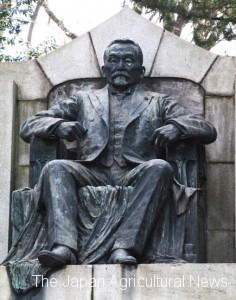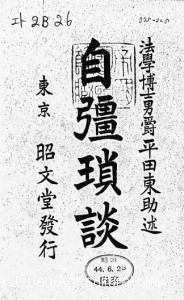“Gyunabe (sukiyaki) Meeting” constructed basis

Statue of Tosuke Hirata located in the site of national education center of JA (Machida city, Tokyo)
After enactment of sangyokumiai law, 5 years have passed. On February 22, 1905 (Meiji 38), officials and experts involved in sangyokumiai such as the Ministry of Agriculture and Commerce, the Ministry of Interior, and the Ministry of Finance were gathered in Western shop “Fujimiken” in Kojimachi Ward, Tokyo (now Chiyoda-ku, Tokyo). The interrogation was made by Tosuke Hirata (before Minister of Agriculture and Commerce) and Tsuneaki Sako (Director of the Ministry of Agriculture and Commerce) .
The subscription to the sangyokumiai (cooperatives) gradually increased. Aiming for guidance, encouragement, and further spread, Hirata felt strongly the need for a central authority of the cooperatives themselves, except for the prefecture office and nokai (chamber of agriculture). Center agenda of the day was the establishment and its date for “Dainihon Sangyokumiai chuokai (association of cooperatives of Japan)” as a voluntary organization.
On the day, the local Secretaries had come to Tokyo for another meeting. Hirata and another stuff asked them the inauguration of the founders and special members of the association, and nominated executive appointments within this day. In it Hirata was appointed to president, and Hisayoshi Kano (secretary general of Zenkoku nojikai (National Chamber of Farming)) and Eitaro Komatsubara (Minister of Education, later) were appointed to the vice presidents. Tsunenori Nishigaki, rectangular, created the proceedings.
The purposes of chuokai were as follows; Encouragement of establishment of sangyokumiai, guidance of the business for sangyokumiai, mutual contact among sangyokumiai, holding events such as lectures on sangyokumiai, investigation related sangyokumiai, response to member sangyokumiai regarding the question, and the issue of the newsletter.
On March 1, 1905, Dainihon Sangyokumiai chuokai (association of cooperatives of Japan) was established. It was the birth of egg of the current JA-ZENCHU (Central Union of Nogyokyodokumiai (agricultural cooperatives)).
Devoted donation by Hirata, President
Hirata provided his house, located at Kandasurugadai, as of the office of Dainihon Sangyokumiai chuokai (association of cooperatives of Japan). In 1908 (Meiji41), the office was moved to Hirata’s house located at Kandaogawamachi. The association purchased an independent office to Kandamisakimachi so as not to depend too much in favor of Hirata. Management of the association was mainly played by the primary and secondary President, Tozaburo Tsukita of the Ministry of agriculture and commerce (after president of the association), Yoshio Udo (after vice president of the association), Kunio Yanagida (after the folklorist), Kanji Sato (after the dean of Faculty of Agriculture of Tokyo Imperial University). In addition, 10 people as canons and 120 people as councilors worked at the association.
Regarding organization and business, the association referred to the European agricultural organizations. Although the association had took the form of being established by voluntarily, it could be seen that the organization was semiofficial in terms of lineup of staff.
Udo, Tsukida, and Sato went to work in the office on a daily basis, to discuss the basic establishment of the association. Operation organization was to be set. Major staff became manager called Shuji (secretary), and Shujikai (secretary meeting) became the center of planning and business development.
Shujikai was held 1, 2 times a month, at the office at 17 o’clock. Because shujikai was held while eating Gyunabe (sukiyaki (boiled thin slices of beef in soy sauce, cooked with various vegetables)), shujikai began to be called as “Gyunabekai (Gyunabe meeting)”. It became really frank propulsion engine of the association, so that the proceedings went off smoothly.
Everyone recognized that in all aspects of management President Hirata made efforts devotedly. “Member sangyokumiai submits the subscription application form not accompanied by membership fee. When the association was in need of funds, President Hirata advanced funds on behalf of the association. The amount was said to be enormous. Later the association offered repayment for him, but Hirata refused and contributed it to the Basic property.”(Sato Kanji Den Kankokai (association of publication of biography of Kanji Sato),” Sato Kanji Den (Biography of Kanji Sato)”).
In this atmosphere, a series of encouraging business of sangyokumiai business was born one after another. One of them was dissemination tour of sangyokumiai in October 1907 (Meiji 40). President Hirata was responsible for western area from Tokaido, and vice president Komatsubara was responsible for Tohoku (north east) area. Hisayoshi Kano also opened the lectures and farming guidance meetings sewing the intervals of work of the cooperatives president. At the same time, the association decided to establish its branch offices responsible for the systematic contact between the sangyokumiai and the association. The association encouraged establishment of branch offices in each prefecture. In response, starting with Shizuoka and Chiba, at last 29 branch offices were formed by the end of 1909 (Meiji 42).


